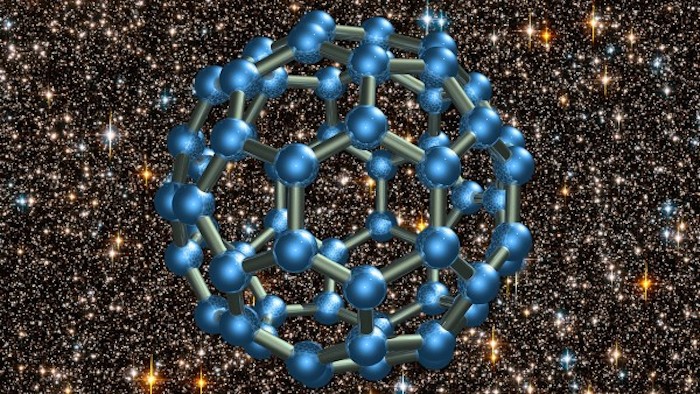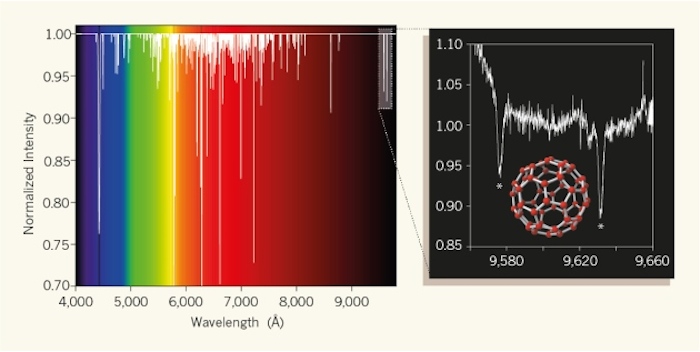.

Zapped with cosmic rays and ultraviolet light, the space between the stars is so hostile that most astronomers once thought it couldn't possibly harbor something as fragile as molecules. Nevertheless, observers have found lots of interstellar molecules, some simple and others complex. Now, as chemists report online today in Nature, buckyballs—complex molecules with 60 carbon atoms arranged into what look like the geodesic domes of R. Buckminster Fuller—do indeed exist in the space between the stars. Two decades ago, astronomers found interstellar spectral lines at near-infrared wavelengths and said they likely arose from carbon-60 molecules that had lost one electron each. In the new work, the chemists cooled gaseous buckyballs in the laboratory to frigid interstellar temperatures and measured the spectrum of the gas, finding lines at wavelengths of 9577 and 9632 angstroms. That matches what the astronomers saw and, because our solar system arose from interstellar material, suggests that some of the carbon now in our bodies was once in the form of buckyballs.
Quelle: AAAS
-
Buckyballs in space solve 100-year-old riddle
Spheres of carbon-60 responsible for mysterious cosmic-light features.
.

A spectrum of the interstellar medium (left) shows 400 'diffuse interstellar bands', where unknown molecules absorb specific wavelengths of light. Buckyballs (right) have been identified as responsible for two of these mysterious features. (Image: Ehrenfreund, P. et al Nature 523 296-297; 2015).
Carbon cages floating in the space between the stars have been confirmed as the cause of cosmic-light features that have puzzled astronomers for almost 100 years.
In 1919, Mary Lea Heger, a graduate student at the University of California’s Lick Observatory on Mount Hamilton, saw that particular wavelengths of light were dimmed in the emissions from certain stars, in a way that seemed unrelated to the stars themselves. As astronomers spotted more such features, they attributed them to molecules in the interstellar gas that absorb wavelengths of light on their way to Earth, and called them diffuse interstellar bands (DIB). Some 400 DIBs have now been observed, from across the Milky Way and beyond.
Dust grains, carbon chains and even floating bacteria emerged as candidates to explain these features, but none proved conclusive. Now, a laboratory analysis of the light absorbed by buckyballs — hollow, soccer-ball shaped molecules made up of 60 carbon atoms — under space-like conditions has provided direct match for DIBs seen in 19941. They are the first DIBs to be explained.
In 1919, Mary Lea Heger, a graduate student at the University of California’s Lick Observatory on Mount Hamilton, saw that particular wavelengths of light were dimmed in the emissions from certain stars, in a way that seemed unrelated to the stars themselves. As astronomers spotted more such features, they attributed them to molecules in the interstellar gas that absorb wavelengths of light on their way to Earth, and called them diffuse interstellar bands (DIB). Some 400 DIBs have now been observed, from across the Milky Way and beyond.
Dust grains, carbon chains and even floating bacteria emerged as candidates to explain these features, but none proved conclusive. Now, a laboratory analysis of the light absorbed by buckyballs — hollow, soccer-ball shaped molecules made up of 60 carbon atoms — under space-like conditions has provided direct match for DIBs seen in 19941. They are the first DIBs to be explained.
Quelle: nature
4552 Views
